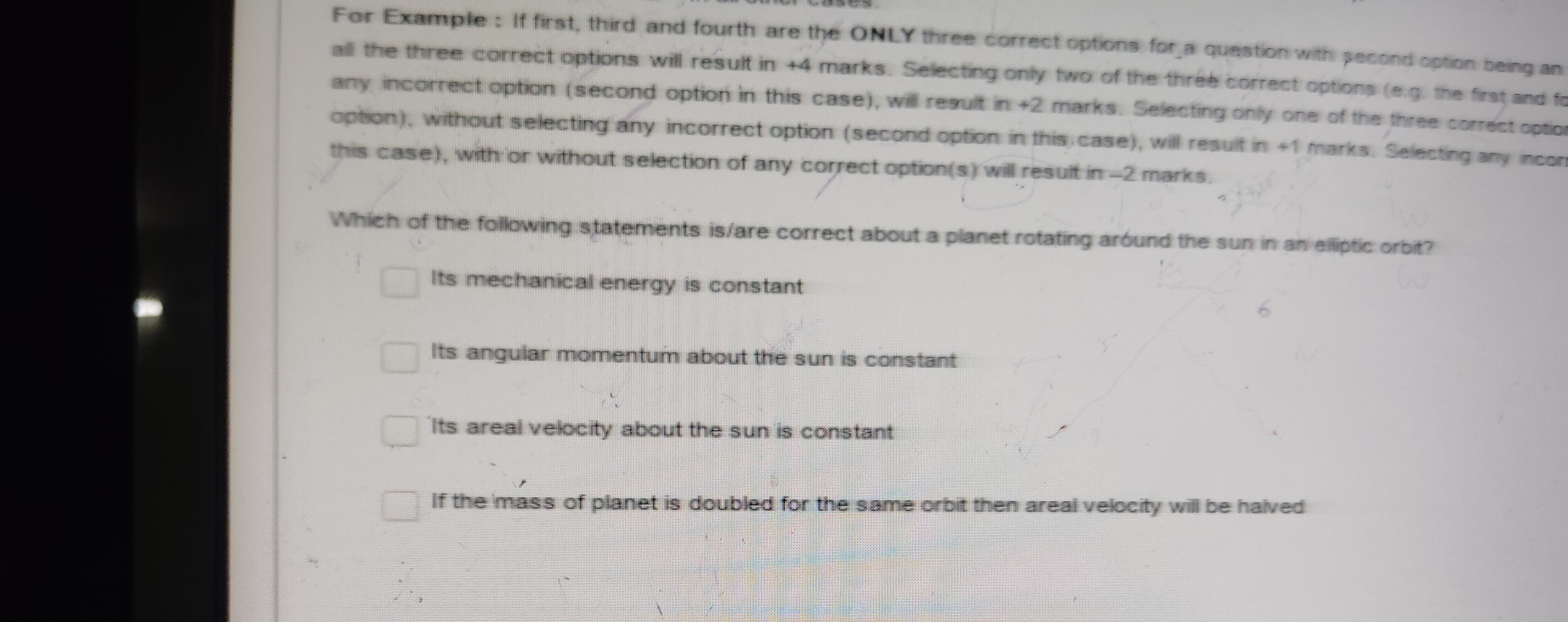Question
Question: Which of the following statements is/are correct about a planet rotating around the sun in an ellipt...
Which of the following statements is/are correct about a planet rotating around the sun in an elliptic orbit?

Its mechanical energy is constant
Its angular momentum about the sun is constant
Its areal velocity about the sun is constant
If the mass of planet is doubled for the same orbit then areal velocity will be halved
Its mechanical energy is constant, Its angular momentum about the sun is constant, Its areal velocity about the sun is constant
Solution
Let's analyze each statement regarding a planet rotating around the sun in an elliptic orbit:
-
Its mechanical energy is constant: The gravitational force between the sun and the planet is a conservative force. In the absence of non-conservative forces, the total mechanical energy of the planet (sum of kinetic and potential energy) is conserved. For an elliptical orbit with semi-major axis a, the total mechanical energy E=−2aGMm, where G is the gravitational constant, M is the mass of the sun, and m is the mass of the planet. Since G, M, m, and a are constant for a given orbit, the mechanical energy E is constant. This statement is correct.
-
Its angular momentum about the sun is constant: The gravitational force exerted by the sun on the planet acts along the line joining their centers. This is a central force. The torque exerted by a central force about the center of force (the sun) is zero (τ=r×F=0 since F is parallel to r). According to Newton's second law for rotation, the rate of change of angular momentum is equal to the net torque (dtdL=τ). Since the torque is zero, the angular momentum L about the sun is constant. This statement is correct.
-
Its areal velocity about the sun is constant: The areal velocity (dA/dt) is the rate at which the line joining the planet to the sun sweeps out area. It is related to the angular momentum L by the formula dA/dt=2mL, where m is the mass of the planet. Since the angular momentum L is constant and the mass m is constant, the areal velocity dA/dt is constant. This is Kepler's Second Law of planetary motion. This statement is correct.
-
If the mass of planet is doubled for the same orbit then areal velocity will be halved: The areal velocity is given by dA/dt=2mL. The statement "for the same orbit" implies that the orbital path is identical. For the orbital path to be identical, the velocity v at each point r must be the same. The angular momentum is L=r×mv. If the mass of the planet is doubled from m to m′=2m, and the velocity v remains the same for the same orbit, then the new angular momentum is L′=r×(2m)v=2(r×mv)=2L. The new areal velocity is (dA/dt)′=2m′∣L′∣=2(2m)∣2L∣=4m2∣L∣=2m∣L∣. This is the same as the original areal velocity. Therefore, if the mass is doubled for the same orbit, the areal velocity remains the same, not halved. This statement is incorrect.
Based on the analysis, statements 1, 2, and 3 are correct.
